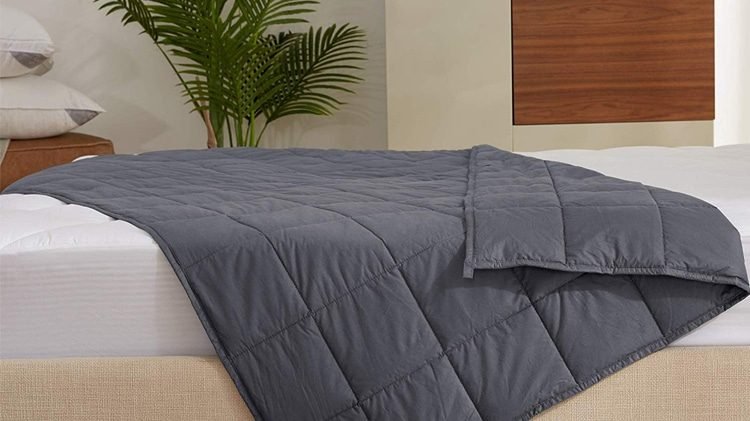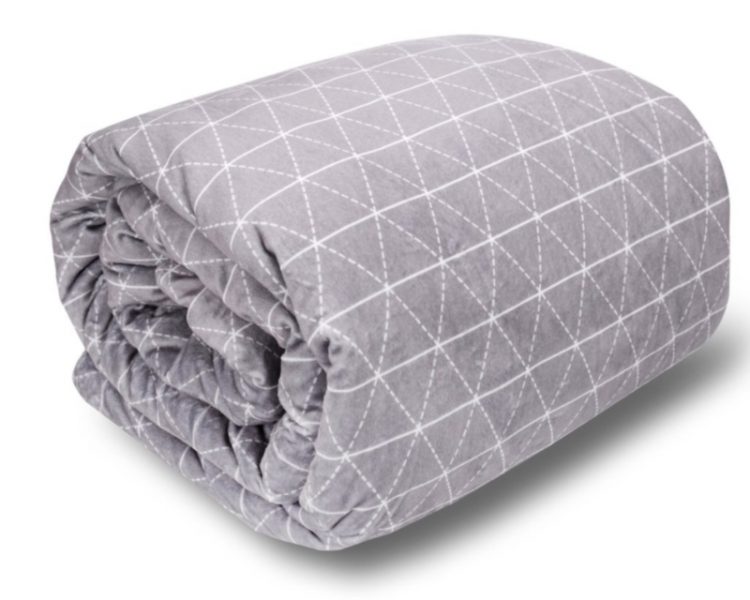Fibromyalgia is a debilitating medical condition that causes a person to feel constant pain and fatigue throughout the day.
Interestingly, the pain isn’t always due to a physical hurt. A person with fibromyalgia feels persistent and widespread body pains even while doing nothing at all.
Statistics show this condition affects nearly 4 million American adults, excluding undiagnosed cases. However, there is a limited understanding of what causes the condition, and most people just don’t understand the problems sufferers face.
People with fibromyalgia find it truly difficult to relax. Regular daily activities become exasperating. The symptoms usually leave a person fatigued and unable to stay comported.
A weighted blanket can ease fibromyalgia symptoms and help sufferers to find restful sleep. The pressure from a weighted blanket provides soothing sensory input to the body’s Deep Pressure Touch (DPT) zones, triggering the release of Serotonin and Endorphins – The body’s “relaxation” hormones. This can help them feel more comfortable.
What causes fibromyalgia?
At the core of fibromyalgia symptoms is heightened brain activity that causes a sufferer to be oversensitive to things that may feel normal to other people.
What exactly causes the pain?
While the pain people with fibromyalgia face is very real, and a constant daily feature of daily life in a sufferer, the root cause is not physical, rather it has to do with how the brain interprets signals from the sensory faculties.
At every point in time, our various sensory organs work in tandem with the nerves and spinal cord to relay information to the brain about how our bodies interact with our physical environment.
Throughout the day, the brains of people living with the condition receive pain signals from a stimulus that shouldn’t hurt at all. Worse still, the pain can be felt even without engaging in any activity.
This is one reason why there is yet no medication regimen known to cure the condition.
Findings by medical researchers indicate that fibromyalgia is caused by the brain incorrectly reading pain signals from the spinal cord and nerves.
Other studies suggest that people with the condition may have more pain receptors than regular people, although this isn’t confirmed yet.
This is where a weighted blanket becomes a very effective tool; it has been shown that DPT has profound therapeutic benefits on the brain.
Weighted blankets can help fibromyalgia sufferers to cope with anxiety, stress, pain, and insomnia. Studies have shown that a weighted blanket and other weighted products are able to reduce excessive sensory activity that causes a person to feel overwhelmed.

Who can be affected?
Fibromyalgia affects both men and women, although women are more prone to developing the condition. Women are in fact 50% more likely to develop the condition than men.
Moreover, people are more likely to develop fibromyalgia in adulthood. Currently, over 90% of people with fibromyalgia symptoms are aged over 18 years.
fibromyalgia can also be hereditary – a person might develop it if there is a history of the condition in the family.
What are the symptoms of fibromyalgia?
At present, there is no all-inclusive test to determine if you have fibromyalgia. However, doctors recommend that if you experience a chronic, widespread body pain that lasts for more than three months, you should seek medical attention immediately.
On the onset of fibromyalgia, some sufferers may resort to self-medication to relieve the pain, e.g., using painkillers. This is unadvisable. The safest way to deal with symptoms is to see a qualified physician.
The most prominent feature of fibromyalgia is widespread and chronic musculoskeletal pain. What this means is that the pain affects the muscles, joints, and tendons.
Generally, people experience fibromyalgia symptoms in a recurring fashion, but how often they occur varies from person to person.
Other symptoms include:
- Oversensitivity to stimulus
- Muscle stiffness
- Constant fatigue
- Headaches
Treatment for fibromyalgia
Currently, there is no definite cure for fibromyalgia. However, there are ways to manage daily living with the condition – especially the accompanying pain, discomfort, and constant fatigue. Many people have been managing the condition for decades with the following:
Medication
Drug-based treatment options are not a definite cure but can deal with the pain by reducing nervous system activity. They include the use of medication like anti-inflammatory and pain-relief drugs.
Lifestyle changes
Exercising more often and eating healthy can also help to alleviate some fibromyalgia symptoms, but won’t cure it.
Physical therapy: weighted blankets
An alternative treatment for fibromyalgia is physical therapy. A weighted blanket can form part of a physical therapy routine to help many people cope with the symptoms. Sensory input from the weighted blanket is effective in alleviating the pain and discomfort experienced by most sufferers.
What’s it like living with the condition?
The most prominent indication of fibromyalgia is a chronic, widespread pain, although there are many other symptoms.
Common difficulties people living with the condition face on a daily basis include:
- Chronic and widespread musculoskeletal pain
- Insomnia
- Restlessness & anxiety
- Sore muscles
- Constant body fatigue
- Difficulty concentrating (Also known as the ‘Fibro fog’)
We’ll be taking a look at how a weighted blanket can help to relieve some of these symptoms in subsequent parts of this article.
But first, let’s learn more about how weighted blankets work.
The science behind weighted blankets
Weighted blankets work by distributing a considerable amount of weight (usually 10% of body total, minimum) over the entire body.

The weight of the blanket ‘pushes’ down on the body in a process known as ‘grounding’ which creates a therapeutic effect on the brain of the user. This then triggers the release of natural stress-relieving hormones like Serotonin and Endorphins which causes the person to feel more relaxed. This is what Deep Pressure Touch (DPT) therapy is all about.
Serotonin is a chemical that produces a ‘calming effect’ in our brains when released. Studies have shown that this chemical is responsible for regulating our moods.
Endorphins have an analgesic effect on the body – meaning that they have the ability to block pain receptors from transmitting signals to the brain.
Endorphins also stimulate a part of the brain called the hypothalamus which induces feelings of pleasure and satisfaction.
Fibromyalgia: Using a weighted blanket to deal with ‘flare-ups’
At certain times, fibromyalgia symptoms can become aggravated and intensified for a period of time. This is known as a ‘flare-up.’
A flare-up can be caused by many reasons including:
- Stress
- Diet change
- Sleep deprivation
- Weather
- Hormones
- An adverse reaction to fibromyalgia medication, etc.
When a flare-up occurs, symptoms become progressively worse over a period of time. This could last anywhere from a few days to several months and cause severe discomfort to a person living with the condition.
A weighted blanket can help to cope with a flare up until it passes. Since symptoms become progressively severe during a flare up, it’s a good idea to choose a weighted blanket with a substantial amount of weight. More on this will be discussed in subsequent sections of this article.
Using a weighted blanket to overcome the “fibro fog”
The constant pain from fibromyalgia symptoms can cause sufferers to become disoriented. Usually, this impairs the mental capacity of a person living with the condition and they are unable to concentrate.
Some people complain of a ‘fuzzy-headed’ feeling and distorted thought patterns during the day. This is also known as ‘fibro fog.’
The fibro fog is a natural ‘fight or flight’ response to overstimulation of the brain. It could create problems at the office for sufferers who work jobs that require considerable mental input.
The best way to overcome the fog is to take a break from mentally tasking activity, although this may not always be appropriate at the time.
A weighted blanket can help the person feel less disoriented when wrapped around the body in a prone or sitting position.
Weighted blankets for restlessness & anxiety
People living with fibromyalgia might find it difficult to stay calm throughout the day. If a person also has restless leg syndrome (RLS), it could aggravate it further.
Anxiety often results from the pain and discomfort of many sufferers. Some people will experience mood fluctuations throughout the day.
If you have any of these symptoms, you could wrap a weighted blanket around your body in a prone or sitting position. You can also place it over your trunk, shoulders or any other part of your body where you feel pain.
Using a weighted blanket to overcome insomnia
Insomnia is one of the commonest problems people living with fibromyalgia face.
The widespread body pain and discomfort of living with the condition could make it very difficult to get into a relaxed state necessary for restful sleep. Most sufferers are either unable to fall asleep quickly or sleep through the night.
Sleep deprivation
Sleep deprivation translates to getting anything less than 7 hours of sleep at night. Fibromyalgia symptoms can significantly shorten sleep duration if left untreated.

When a person with fibromyalgia is sleep-deprived, it creates further problems like diminished daytime productivity and even leads to depression.
How a weighted blanket can help
Deep pressure touch stimulation from a weighted blanket forces the body to relax by a process known as ‘grounding.’ The experience of using a weighted blanket is similar to getting a ‘tight’ hug from a loved one.
Studies have shown that DPT has a therapeutic effect on the brain that helps a person to fall asleep faster and sleep for longer.
Selecting the right weighted blanket for fibromyalgia
The two most important criteria for choosing a weighted blanket are weight and size.
Knowing your own body dimensions before selecting a weighted blanket will help you safeguard your investment because a weighted blanket must be chosen based on the body dimensions of the intended user.
Weight
When it comes to selecting a weighted blanket to ease fibromyalgia, just choosing any weight won’t do. The right weighted blanket must suit your own body weight to give you optimum benefits.
A suitable weight for a weighted blanket should be at least 10% of your body weight. However, since fibromyalgia symptoms can be quite severe, some OTs advice using anywhere from 10-15% of body weight.
Alternatively, you could purchase a blanket that is 10% of your body weight plus one or two extra lbs. if you find the weight of the heaviest blankets overwhelming.
Note: Many Occupational Therapists advise basing your calculations on your ideal body weight.
What’s my ideal body weight?
Your ideal body weight is your optimum healthy weight based on your age, gender, and current fitness level. It isn’t necessarily what you weigh now, but what you could weigh in the future.
How can I calculate it?
For more on how to calculate your ideal body weight, please see our article on picking the right weight and size.
How heavy is too heavy?
While a weighted blanket should offer considerable weight to alleviate fibromyalgia symptoms, you should find it easy to take a weighted blanket off by yourself without feeling trapped.
Before buying a weighted blanket, you should try it on and see if it feels comfortable. If you find the weight too overwhelming and you’re not claustrophobic, you should pick a lighter one.
Size
A weighted blanket should be large enough to swaddle the entire body whether in a prone or sitting position.
The two most important measures to consider are the length and width. You can also use the dimensions of your bed to determine a suitable size to swaddle your body completely.
The common weighted blanket sizes are Small, Medium, and Large. Common dimensions are:
- 38 inches x 50 inches for a small-sized blanket
- 38 inches x 60 inches for medium size
- 42 inches x 72 inches for a large-sized blanket
Note: Dimensions may vary, depending on the weighted blanket manufacturer’s specifications.
However, it’s possible to order a custom-made blanket to suit your unique needs and preferences.
Bear in mind that a weighted blanket is not meant to be used as a cover for your bed, but to be wrapped around your body while sleeping or sitting.
Last words
The constant pain from fibromyalgia can leave a person feeling exhausted and disoriented.
Using a weighted blanket provides just the right amount of sensory input to help a person living with fibromyalgia cope with the pains, insomnia, and discomfort.
If you’re buying a weighted blanket for someone else, it’s a good idea for them to be involved in the selection, so they can find a blanket they feel most comfortable using.
Choosing a blanket of a suitable weight and size is critical to provide them with all the comfort they can get.

